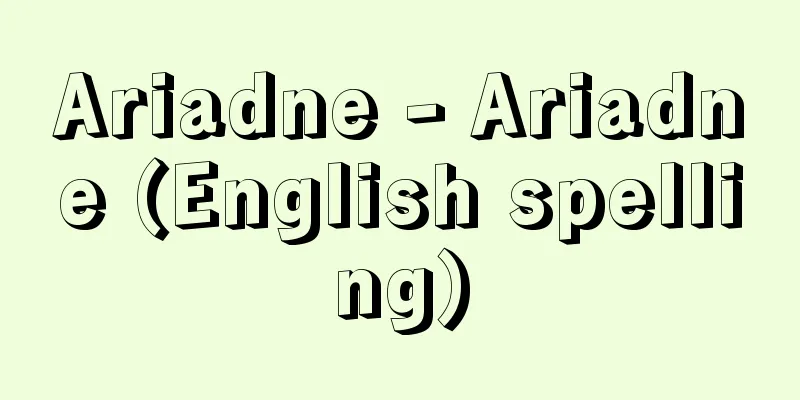Chromosomal aberrations

|
An abnormality that appears in the number and structure of an organism's chromosomes. The number and shape of chromosomes are constant among organisms, and form the genetic basis of each organism. However, abnormalities in the standard number and shape of chromosomes can occur naturally or through radiation or drug treatment, and are also called chromosomal mutations. Chromosomal abnormalities are broadly divided into two categories: chromosomal number and structural abnormalities. [Toshihide Yoshida] Abnormalities in chromosome numberNormal somatic cells have a diploid (2n) number of chromosomes, which is the combination of half (n) of the chromosomes from sperm and half (n) from the egg. For example, the normal number of chromosomes in humans is 46, with 23 derived from the mother and the other 23 from the father. Cells with a number of chromosomes that is different from the normal diploid number are abnormal, and cells with only half the number of chromosomes are called haploid, and cells with three or more sets of chromosomes are called polyploid. Haploids and polyploids are often observed in plants, and polyploid cultivation is particularly important as a breeding method. However, they are rare in animals, and have only been produced experimentally in frogs and other animals. An individual with one or several chromosomes away from the basic number of chromosomes of a species is called an aneuploid (or aneuploidy). Cells with more chromosomes are called high aneuploids (sex), and cells with fewer chromosomes are called low aneuploids (sex). When there is one more chromosome than 2n, it is called trisomic (2n+1), and when there is one less, it is called monosomic (2n-1). Aneuploidy refers to the increase or decrease of a chromosome within normal diploidy, but when an extra chromosome that is not homologous to any other chromosome is included, it is called an extra chromosome or B-chromosome. [Toshihide Yoshida] Structural abnormalities of chromosomesWhen one end of a chromosome is reversed, it is called an inversion; when a part is missing, it is called a deletion; when a part is duplicated, it is called a duplication; and when part or all of a chromosome combines with another homologous chromosome or a non-homologous chromosome, it is called a translocation. Chromosomal abnormalities and numerical abnormalities in chromosomes are caused by abnormal distribution of chromosomes during cell division. If only nuclear division occurs without cell division, polyploid cells (4n) result. If, as cell division progresses and daughter chromosomes migrate to both poles, two daughter chromosomes mistakenly do not separate and migrate to one pole as is, a phenomenon known as nondisjunction, resulting in aneuploid cells. The main cause of structural abnormalities in chromosomes is the breakage and recombination of chromosomes. When breaks occur in chromosomes, most of them recombine as is, but sometimes the broken pieces are lost or recombine with the broken pieces of other chromosomes. Depending on when chromosome breakage occurs in the cell division cycle, the type of structural abnormality that appears during metaphase differs. Numerical or structural abnormalities in chromosomes can cause mutations. For example, an individual with an extra human 21st chromosome has a condition called trisomy 21, which results in Down syndrome. A man with an extra X chromosome has a sex chromosome configuration of XXY, resulting in Klinefelter syndrome, while a monosomic X woman who is missing one X will have Turner syndrome. These are caused by non-disjunction of the 21st or X chromosome during egg or sperm formation. Even if there is a structural abnormality in chromosomes, if there is no change in the total amount of chromosomes, there are often no abnormalities in the expression of traits. [Toshihide Yoshida] [Reference] | |Source: Shogakukan Encyclopedia Nipponica About Encyclopedia Nipponica Information | Legend |
|
生物の染色体の数および構造上に現れる異常のこと。生物は種によって染色体の数と形は一定で、それぞれの生物種の遺伝的な基礎となっている。しかし、自然にまたは放射線や薬物処理などによって、基準となる染色体の数や形のうえに異常の生ずることがあり、染色体突然変異ともいう。染色体異常は染色体数と構造異常の二つに大別される。 [吉田俊秀] 染色体数の異常正常な体細胞は精子および卵子由来のそれぞれ半数(n)の染色体が合体して二倍性(2n)の染色体数をもっている。たとえばヒトの二倍性(2n)の正常染色体数は46本で、23本は母方から、ほかの23本は父方から由来した。正常二倍性より離れた染色体数をもつ細胞は異常で、半数の染色体しかもたない場合を半数体、3組以上の染色体をもつものを倍数体という。植物では半数体や倍数体はしばしば観察され、とくに倍数体育成は育種法の一つとして重要視されている。しかし、動物ではまれで、実験的にカエルなどで作出されている程度である。生物種の基本染色体数よりも1個から数個離れた染色体をもった個体を異数体(または異数性)という。染色体が多い場合を高異数体(性)、少ない場合を低異数体(性)とよぶ。2nよりもある染色体が1個多い場合をトリソミック(2n+1)、また1個少ない場合をモノソミック(2n-1)という。異数性は正常二倍性の中に含まれているある染色体の増減の場合をいうが、ほかのどの染色体とも相同でない染色体が余分に含まれている場合は、これを過剰染色体またはB‐染色体という。 [吉田俊秀] 染色体の構造異常染色体の一端が逆転している場合を逆位、一部分が失われている場合を欠失、一部分が重複している場合を重複、染色体の一部または全部が相同のほかの染色体、または相同以外の染色体と結合する場合を転座などとよぶ。 染色体異常の原因や染色体の数的異常は、細胞分裂時の染色体の異常配分に原因する。核分裂のみがおこって細胞分裂が伴わないと倍数性細胞(4n)になる。細胞分裂が進行して娘(じょう)染色体が両極へ移行するとき、誤って2個の娘染色体が分離しないでそのまま一方の極へ移行すると、いわゆる不分離現象がおこって異数性細胞が生ずる。染色体の構造異常のおもな原因は染色体の切断と再結合である。染色体に切断がおこっても大部分はそのまま再結合するが、切断されたものがそのまま失われたり、ほかの染色体の切断片と再結合することがある。染色体切断が細胞分裂周期のどの時期におこるかによって、分裂中期に現れる構造異常の型に差異が現れる。 染色体の数的または構造的な異常は突然変異の原因となる。たとえば、ヒトの21番目の染色体を1個余分にもった個体は21トリソミーとよばれてダウン症候群となる。X染色体を1個余分にもった男性はXXYの性染色体構成となって、クラインフェルター症候群となり、逆に1個のXを欠いたモノソミックXの女性はターナー症候群となる。これらは卵子または精子形成時の第21番目の染色体またはX染色体の不分離現象に起因する。染色体の構造的な異常があっても染色体の総体量に変化がおこらない場合には、形質発現上異常を伴わないことが多い。 [吉田俊秀] [参照項目] | |出典 小学館 日本大百科全書(ニッポニカ)日本大百科全書(ニッポニカ)について 情報 | 凡例 |
Recommend
Cake-urchin - Cake-urchin (English name)
A general term for marine animals belonging to th...
Istiophoridae
…General term for fishes belonging to the Istioph...
Lang yá (English spelling)
An ancient place name in China. It is also written...
Kairoudoketsukaimen (English spelling) Venus' flower basket
A general term for marine sponges of the Euplectel...
Taishan Fukun
An ancient name for the god of Mount Taishan in D...
Shintaro Awaya
… It is regrettable that the masks and costumes h...
Oku seven districts
...In Shinano, the northern counties of Sarashina...
Kamakura Riverbank
A riverbank in Uchikanda, Chiyoda Ward, Tokyo. It ...
Convection - taiyu
When water is placed in a kettle and heated from ...
Asabasho - The Asabasho
This is the only iconographical collection in the ...
Expression of Intention - Ishihyoji
It refers to an act of expressing one's inten...
An Su‐gil (English spelling)
1911‐77 Korean author. Born in Hamhung, South Hamg...
Business Police - Eigyo Keisatsu
Police action to crack down on commercial, industr...
Floating piece - Ukigoma
… [Other terms] A free piece is a piece that is n...
Mourning poem (English: 'Touboshi')
A poem lamenting the death of one's wife. In C...









